长安奔奔MINI空调系统维修手册
- 格式:doc
- 大小:1.82 MB
- 文档页数:21
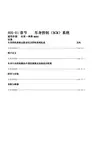
405-01章节车身控制(BCM)系统适用车型: 长安·奔奔MINI目录车身控制系统功能说明及控制系统组成页码车身控制器………………………………………………………………………………………405-01-2 端子定义车身控制器………………………………………………………………………………………405-01-4 车身中央控制模块外围连接图及保险盒分配图车身控制器………………………………………………………………………………………405-01-6 拆卸与安装车身控制器………………………………………………………………………………………405-01-7 诊断与维修车身控制器………………………………………………………………………………………405-01-8一车身控制系统功能说明及控制系统组成1 系统功能说明:1.1左右转向功能点火开关为ON档时,分别激活左/右转向开关,左/右转向灯闪烁且闪烁频率为360ms-ON/360ms-OFF,同时驱动外部继电器模拟转向声音(Z104)。
1.2灯丝失效报警如果发生转向灯丝失效(只有前、后转向灯),闪烁频率是通常的2倍,为180ms-ON/180ms-OFF,同时等频率驱动外部转向灯发声继电器。
侧面转向灯的失效不会引起频率的改变。
1.3变道闪光功能点火开关为ON档时,在100ms<t<700ms时间内把转向开关OFF→ON→OFF,相应一侧的转向灯闪烁三次,同时,在灯闪烁三次期间如再有100ms<t<700ms的开关信号,车身中央控制模块不响应。
1.4转向与变道优先级当激活左/或右变道闪光功能时,如又激活右或左转向开关,则转向信号优先,并取消左和右变道闪光功能。
1.5危险报警灯光功能激活紧急报警开关,左、右转向灯同时闪烁且闪烁频率为360ms-ON/360ms-OFF,再次按压开关,则取消。
1.6转向与危险报警优先级点火开关为ON档时,如果先激活紧急报警开关,再激活左/右转向灯开关,则危险报警信号优先;如果先激活左/右转向灯开关,再激活紧急报警开关,则紧急报警信号优先。
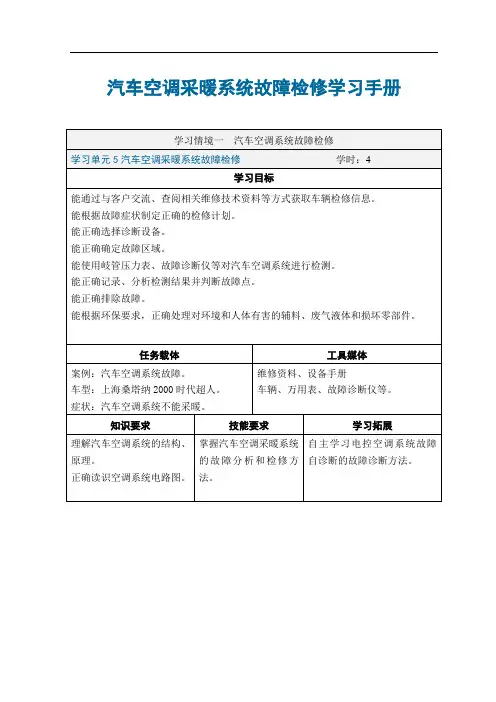
汽车空调采暖系统故障检修学习手册1.5.1 采暖系统的功用采暖系统也称暖风系统,在汽车空调系统中,采暖是重要的功能之一。
汽车空调采暖系统的功用如下:1.冬季取暖在寒冷的冬季,汽车空调采暖系统可将车内空气或送入车内的外部新鲜空气加热,以提高车内空气温度。
2.调节车内温度与湿度现代汽车空调系统的空调器已采用冷暖一体化的形式,利用空调制冷系统和采暖系统,通过冷、热风的调和,可对车内的温度与湿度进行调节,以提高车内的舒适性。
3.车窗玻璃除霜在冬季或春季,由于车内、外温差较大,车窗玻璃会起雾和结霜,影响驾驶员的视线,不利于行车安全。
这时,可通过采暖系统吹出热风来除霜、除雾。
1.5.2 采暖系统的类型按热源不同,汽车空调采暖系统常见的可分为二种类型:余热式采暖系统与独立式采暖系统。
余热式采暖系统是利用发动机冷却水对车内空气进行加热的。
轿车的车内空间小,取暖需要的热量也少,所以一般都装用余热水暖式采暖系统。
该系统的优点是设备简单、使用安全、运行经济,缺点是热量小,且采暖受发动机工况的影响。
独立式采暖系统是利用独立的热源对车内空气或送入车内的外部新鲜空气加热。
独立热源通常是燃烧汽油、柴油或煤油等燃料的燃烧器。
独立式采暖系统也可分水暖和气暖两种。
大型客车常常采用独立式采暖系统。
独立式采暖装置的优点是采暖不受发动机工况影响,发动机不工作时也可对车内供热。
独立式采暖装置通常是利用空气或水作为传热介质,因此,其主要类型有空气加热采暖系统和水加热采暖系统。
1.5.3 余热水暖式采暖系统1.工作原理余热水暖式采暖系统工作原理如图1-98所示。
发动机冷却水温达到80℃时,冷却系中的节温器主阀门开启,使冷却水进行大循环。
节温器和加热器之间装有一个热水阀,需要采暖时,打开此热水阀。
从发动机水套出来的热水流经节温器主阀门后,一部分流到供暖系统的加热器,另一部分流到散热器散热。
进入加热器内的热水向加热器周围空气传热,在鼓风机作用下,车内或外部新鲜空气经过加热器后,冷空气变成了热空气,热空气经通风管道的不同出风口被送入车内。
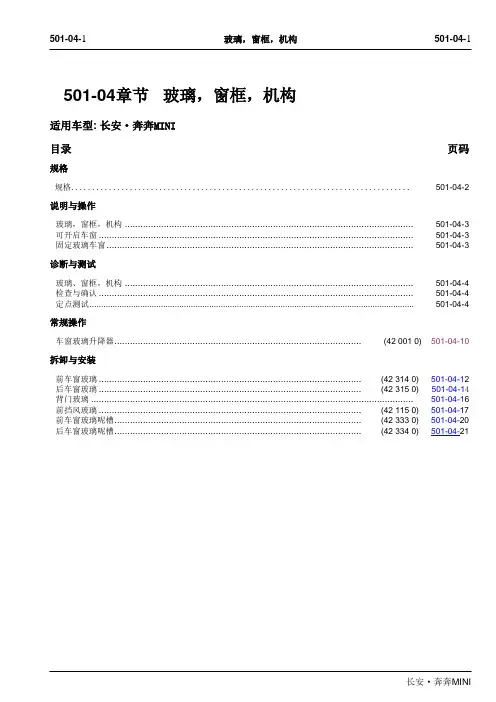
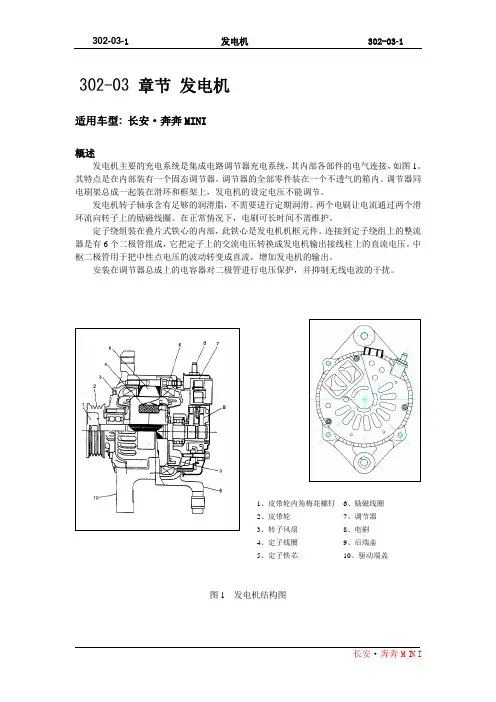
302-03章节发电机适用车型: 长安·奔奔MINI概述发电机主要的充电系统是集成电路调节器充电系统,其内部各部件的电气连接,如图1。
其特点是在内部装有一个固态调节器。
调节器的全部零件装在一个不透气的箱内。
调节器同电刷架总成一起装在滑环和框架上,发电机的设定电压不能调节。
发电机转子轴承含有足够的润滑脂,不需要进行定期润滑。
两个电刷让电流通过两个滑环流向转子上的励磁线圈。
在正常情况下,电刷可长时间不需维护。
定子绕组装在叠片式铁心的内部,此铁心是发电机机框元件。
连接到定子绕组上的整流器是有6个二极管组成,它把定子上的交流电压转换成发电机输出接线柱上的直流电压。
中枢二极管用于把中性点电压的波动转变成直流,增加发电机的输出。
安装在调节器总成上的电容器对二极管进行电压保护,并抑制无线电波的干扰。
1、皮带轮内角梅花螺钉6、励磁线圈2、皮带轮7、调节器3、转子风扇8、电刷4、定子线圈9、后端盖5、定子铁芯10、驱动端盖图1 发电机结构图1、带调节器总成的发电机6、充电指示灯2、集成电路调节器7、点火开关3、定子线圈8、蓄电池4、整流二极管9、负载5、励磁线圈(转子线圈)图2 发电机性能测试图故障诊断为了避免发电机的损坏,一定要注意以下事项如发生下述一种或多种请况时,则表明充电系统发生故障:1、故障指示灯亮。
2、起动缓慢或指示灯灯光不明亮,则表明蓄电池充电不足。
3、电解液过多的从通气孔渗出,说明蓄电池过渡充电。
发动机出现噪声是由于以下原因造成的:主动皮带轮松动、安装螺栓松动,轴承磨损或有赃物或二极管不良或定子不良。
故障指示灯光蓄电池充电不足起动缓慢是由于下列一种或几种情况造成的,即使指示灯正常工作也是这样。
用电压表和安培表对车辆实施下面步骤。
1、确保蓄电池充电不足不是因为辅助设备一直开着造成的。
2、检查传动皮带松紧度是否正常。
3、如怀疑蓄电池故障,参见“蓄电池”一节的说明4、检查线路是否有故障,检查各连接处是否紧固及是否清洁。

关于奔奔MINI、悦翔组合仪表维修指导性说
明的通知
各大区、服务中心、授权专营店及特约服务站:
请加强学习奔奔MINI、悦翔组合仪表维修指导性的说明并要求熟练掌握。
现对最近市场反映的问题进行梳理和汇总,维修方法如下:
问题一:平均油耗由在每次清零后都会由正常合理的平均油耗在很短时间内明显减小甚至有的减小至1L/100Km左右。
排查方法:
主要排查ECU油耗脉冲信号输出到组合仪表的线束,包括中间的转接头是否可靠。
奔奔MINI车型:是ECU56引脚0.5 规格黄白线到组合仪表11引脚
悦翔车型:是ECU56引脚0.3 规格绿色线到组合仪表B4(绿色护套)引脚问题二:怠速时(或怠速+开启空调)平均油耗高,上升变化快(从上次平均油耗清零后到现在所行驶里程较少)怠速时平均油耗不断升高属正常,由于无车速,但实际怠速时所消耗油量仍计算在内,所以平均油耗会有所增加,属正常现象。
问题三:平均油耗几乎在某一值无变化或无明显变化
(从上次平均油耗清零后到现在所行驶里程较多)遇怠速,堵车等工况,平均油耗在短时间内几乎无变化,或变化很小(除非经常怠速、堵车等工况的累积时间也较长)。
长安汽车股份有限公司技术通知
第 2 页 共 2 页
主要是因为平均油耗是从上次平均油耗清零开始计算,如果行驶里程较多,单一一天的油耗可能较高,但拉通与之前的行驶里程平均下来,几乎无变化,或变化很小。
属正常现象。
问题四:组合仪表车速表显示车速比实际车速高接近一倍或低接近一半 组合仪表在换件时,更换上去的新仪表与原车上的旧仪表的件号必须保证相同,否则车速指示会严重不准。
特此通知!
长安轿车事业部客户服务部
二〇一一年九月二十六日。
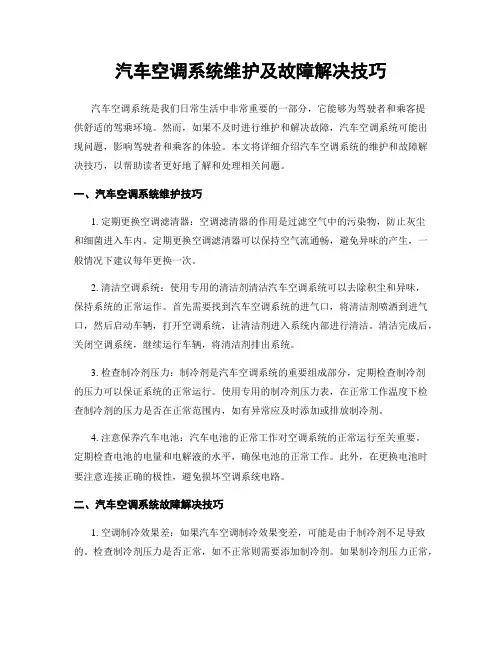
汽车空调系统维护及故障解决技巧汽车空调系统是我们日常生活中非常重要的一部分,它能够为驾驶者和乘客提供舒适的驾乘环境。
然而,如果不及时进行维护和解决故障,汽车空调系统可能出现问题,影响驾驶者和乘客的体验。
本文将详细介绍汽车空调系统的维护和故障解决技巧,以帮助读者更好地了解和处理相关问题。
一、汽车空调系统维护技巧1. 定期更换空调滤清器:空调滤清器的作用是过滤空气中的污染物,防止灰尘和细菌进入车内。
定期更换空调滤清器可以保持空气流通畅,避免异味的产生,一般情况下建议每年更换一次。
2. 清洁空调系统:使用专用的清洁剂清洁汽车空调系统可以去除积尘和异味,保持系统的正常运作。
首先需要找到汽车空调系统的进气口,将清洁剂喷洒到进气口,然后启动车辆,打开空调系统,让清洁剂进入系统内部进行清洁。
清洁完成后,关闭空调系统,继续运行车辆,将清洁剂排出系统。
3. 检查制冷剂压力:制冷剂是汽车空调系统的重要组成部分,定期检查制冷剂的压力可以保证系统的正常运行。
使用专用的制冷剂压力表,在正常工作温度下检查制冷剂的压力是否在正常范围内,如有异常应及时添加或排放制冷剂。
4. 注意保养汽车电池:汽车电池的正常工作对空调系统的正常运行至关重要。
定期检查电池的电量和电解液的水平,确保电池的正常工作。
此外,在更换电池时要注意连接正确的极性,避免损坏空调系统电路。
二、汽车空调系统故障解决技巧1. 空调制冷效果差:如果汽车空调制冷效果变差,可能是由于制冷剂不足导致的。
检查制冷剂压力是否正常,如不正常则需要添加制冷剂。
如果制冷剂压力正常,但制冷效果依然差,可能是由于空调系统的其他部件出现故障,建议前往维修站点进行详细检查和维修。
2. 空调系统漏水:如果发现汽车空调系统有漏水现象,可能是由于密封件老化或损坏导致的。
首先检查空调系统的排水管是否堵塞,如果未发现堵塞现象,可能是密封件需要更换。
如果不了解汽车维修,建议寻求专业人员的帮助。
3. 空调系统异味:如果汽车空调系统散发出异味,可能是由于滤清器或蒸发器上的细菌和霉菌滋生导致的。
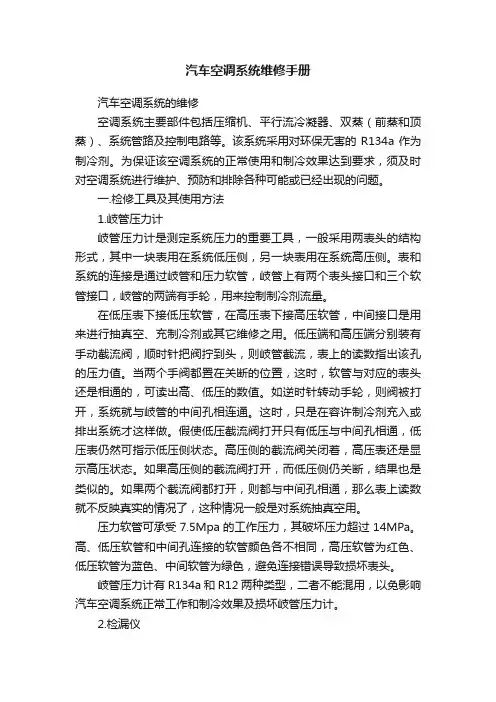
汽车空调系统维修手册汽车空调系统的维修空调系统主要部件包括压缩机、平行流冷凝器、双蒸(前蒸和顶蒸)、系统管路及控制电路等。
该系统采用对环保无害的R134a作为制冷剂。
为保证该空调系统的正常使用和制冷效果达到要求,须及时对空调系统进行维护、预防和排除各种可能或已经出现的问题。
一.检修工具及其使用方法1.岐管压力计岐管压力计是测定系统压力的重要工具,一般采用两表头的结构形式,其中一块表用在系统低压侧,另一块表用在系统高压侧。
表和系统的连接是通过岐管和压力软管,岐管上有两个表头接口和三个软管接口,岐管的两端有手轮,用来控制制冷剂流量。
在低压表下接低压软管,在高压表下接高压软管,中间接口是用来进行抽真空、充制冷剂或其它维修之用。
低压端和高压端分别装有手动截流阀,顺时针把阀拧到头,则岐管截流,表上的读数指出该孔的压力值。
当两个手阀都置在关断的位置,这时,软管与对应的表头还是相通的,可读出高、低压的数值。
如逆时针转动手轮,则阀被打开,系统就与岐管的中间孔相连通。
这时,只是在容许制冷剂充入或排出系统才这样做。
假使低压截流阀打开只有低压与中间孔相通,低压表仍然可指示低压侧状态。
高压侧的截流阀关闭着,高压表还是显示高压状态。
如果高压侧的截流阀打开,而低压侧仍关断,结果也是类似的。
如果两个截流阀都打开,则都与中间孔相通,那么表上读数就不反映真实的情况了,这种情况一般是对系统抽真空用。
压力软管可承受7.5Mpa的工作压力,其破坏压力超过14MPa。
高、低压软管和中间孔连接的软管颜色各不相同,高压软管为红色、低压软管为蓝色、中间软管为绿色,避免连接错误导致损坏表头。
岐管压力计有R134a和R12两种类型,二者不能混用,以免影响汽车空调系统正常工作和制冷效果及损坏岐管压力计。
2.检漏仪检漏是一项非常重要又频繁的基本操作技能。
在汽车空调系统中的检漏方法有肥皂水、卤素检漏灯和电子检漏仪等。
肥皂水检漏是最经济、最简单,也是最有效的方法。
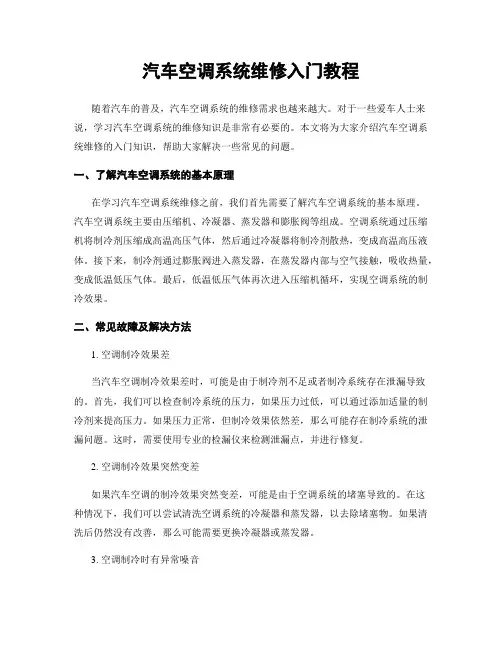
汽车空调系统维修入门教程随着汽车的普及,汽车空调系统的维修需求也越来越大。
对于一些爱车人士来说,学习汽车空调系统的维修知识是非常有必要的。
本文将为大家介绍汽车空调系统维修的入门知识,帮助大家解决一些常见的问题。
一、了解汽车空调系统的基本原理在学习汽车空调系统维修之前,我们首先需要了解汽车空调系统的基本原理。
汽车空调系统主要由压缩机、冷凝器、蒸发器和膨胀阀等组成。
空调系统通过压缩机将制冷剂压缩成高温高压气体,然后通过冷凝器将制冷剂散热,变成高温高压液体。
接下来,制冷剂通过膨胀阀进入蒸发器,在蒸发器内部与空气接触,吸收热量,变成低温低压气体。
最后,低温低压气体再次进入压缩机循环,实现空调系统的制冷效果。
二、常见故障及解决方法1. 空调制冷效果差当汽车空调制冷效果差时,可能是由于制冷剂不足或者制冷系统存在泄漏导致的。
首先,我们可以检查制冷系统的压力,如果压力过低,可以通过添加适量的制冷剂来提高压力。
如果压力正常,但制冷效果依然差,那么可能存在制冷系统的泄漏问题。
这时,需要使用专业的检漏仪来检测泄漏点,并进行修复。
2. 空调制冷效果突然变差如果汽车空调的制冷效果突然变差,可能是由于空调系统的堵塞导致的。
在这种情况下,我们可以尝试清洗空调系统的冷凝器和蒸发器,以去除堵塞物。
如果清洗后仍然没有改善,那么可能需要更换冷凝器或蒸发器。
3. 空调制冷时有异常噪音当汽车空调在制冷过程中发出异常噪音时,可能是由于压缩机或风扇的故障引起的。
我们可以先检查压缩机和风扇是否有异物或杂质,需要清理干净。
如果清理后仍然有噪音,那么可能需要更换压缩机或风扇。
4. 空调制冷时有异味当汽车空调在制冷过程中有异味时,可能是由于空调系统内部的细菌或霉菌滋生导致的。
这时,我们可以使用专业的空调清洗剂进行清洗,以去除异味。
三、维修工具及注意事项在进行汽车空调系统的维修时,我们需要准备一些基本的维修工具,如扳手、螺丝刀、压力表和检漏仪等。
此外,还需要注意以下事项:1. 安全第一:在进行汽车空调系统的维修时,一定要确保车辆处于停车状态,并切断电源。
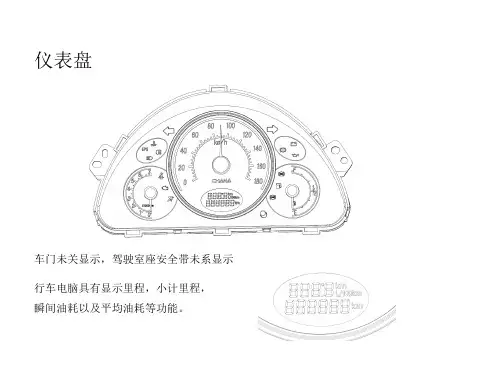
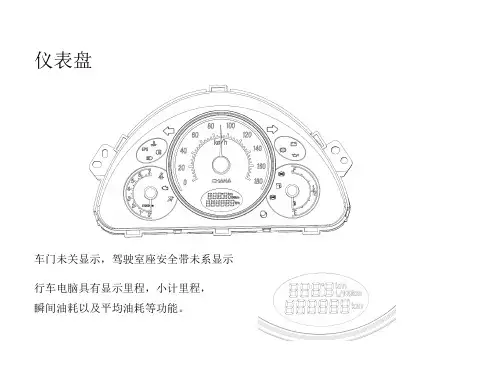
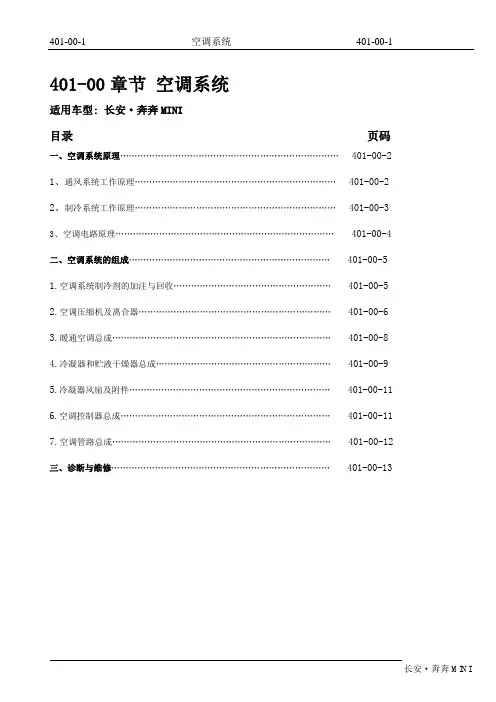
401-00章节空调系统适用车型: 长安·奔奔MINI目录页码一、空调系统原理…………………………………………………………………401-00-21、通风系统工作原理……………………………………………………………401-00-22、制冷系统工作原理……………………………………………………………401-00-33、空调电路原理…………………………………………………………………401-00-4二、空调系统的组成……………………………………………………………401-00-51.空调系统制冷剂的加注与回收………………………………………………401-00-52.空调压缩机及离合器…………………………………………………………401-00-63.暖通空调总成…………………………………………………………………401-00-84.冷凝器和贮液干燥器总成……………………………………………………401-00-95.冷凝器风扇及附件……………………………………………………………401-00-116.空调控制器总成………………………………………………………………401-00-117.空调管路总成…………………………………………………………………401-00-12三、诊断与维修…………………………………………………………………401-00-13采暖、通风、空调系统一、空调系统原理1、通风系统工作原理从空调进风罩开始,新鲜空气经暖通空调系总成,风道,然后到达各个出风口进入车内空间。
2、制冷系统工作原理序号零件号名称1 冷疑器2 压缩机3 干燥瓶4 暖风机–暖风/空调5 蒸发器6 膨胀阀7 冷凝风扇A 高压,液态和高温状态B 低压,液态和低温状态C 低压,气态和低温状态D 高压,气态和高温状态功能气态制冷剂从压缩机入口处吸入,经过压缩机压缩,形成高温高压气体。
(大概1.57Mpa 70°C ~110°C之间)进入冷凝器冷却,通过风扇和迎面风的强制风冷,制冷剂由高温高压气体转换成低温高压液体(低温是相对而言,温度大概在57°C左右)。
Air ConditioningYour car's air conditioning is asealed system. Any major mainte-nance, such as recharging, shouldbe done by a qualified technician.There are a couple of things youcan do to make sure the air condi-tioning works efficiently.Periodically check the engine'sradiator and air conditioningcondenser for leaves, insects, anddirt stuck to the front surface.These block the air flow andreduce cooling efficiency. Use alight spray from a hose or a softbrush to remove them.The condenser and radiator finsbend easily. Only use a low-pressure spray or soft-bristle brushto clean them.AIR CONDITIONINGCONDENSERRun the air conditioning at leastonce a week during the coldweather months. Run it for at leastten minutes while you are drivingat a steady speed with the engine atnormal operating temperature.This circulates the lubricating oilcontained in the refrigerant.If the air conditioning does not getas cold as before, it is probablybecause some of the refrigerant hasleaked from the system. Have yourdealer check the system for leaksand recharge the system withRefrigerant CFC-12 (R-12). (SeeSpecifications on page 208 .)Whenever you have the air condi-tioning system serviced, make surethe service facility uses a refrige-rant recycling system. This systemcaptures the refrigerant for reuse.Releasing refrigerant into the at-mosphere can damage the environ-ment.MaintenanceNOTICENOTICEEngine BeltsCOMPRESSOR BELTCheck the condition of the two engine belts. Examine the edges of each belt for cracks or fraying.Check the tension of each belt by pushing on it with your thumb midway between the pulleys.The belts should have the following "play" or deflection.Alternator belt:7.5-9.5 mm (0.30-0.37 in)Compressor belt:6 — 9 mm (0.2 — 0.4 in)If you see signs of wear or loose-ness, have your dealer adjust or replace the belts.TiresTo safely operate your car, your tires must be the proper type and size, in good condition with adequate tread, and correctlyinflated. The following pages give more detailed information on how and when to check air pressure,how to inspect your tires fordamage, and what to do when your tires need to be replaced.MaintenanceALTERNATOR BELTTiresInflationKeeping the tires properly inflated provides the best combination of handling, tread life and riding comfort. Underinflated tires wear unevenly, adversely affect handling and fuel economy, and are more likely to fail from being overheated.Overinflated tires can make your car ride more harshly, are moreprone to damage from road hazards,and wear unevenly.We recommend that you visually check your tires every day and use a gauge to measure the air pressure at least once a month. If you think a tire might be low, check itimmediately. Remember to check the spare tire at the same time you check all the other tires.Check the pressure in the tireswhen they are cold. This means the car has been parked for at least three hours. If you have to drive the car before checking the tire pressure, the tires can still beconsidered "cold" if you drive less than 1.6 km (1 mile).If you check the pressure when the tires are hot (the car has been driven several miles), you will see readings 28 to 41 kPa (0.3 to 0.4kg/cm 2,4 to 6 psi) higher than the cold reading. This is normal. Do not let air out to match the specified cold pressure. The tire will be underinflated.Recommended Tire Pressures for Normal DrivingThe following chart shows the recommended cold tire pressures for most normal driving conditions and speeds. Tire pressures for high speed driving are shown on page 213.The compact spare tire pressure is:415 kPa (4.15 kg/cm2 , 60 psi)The pressures are also given on the tire information label on the front passenger's door jamb.MaintenanceTiresYou should get your own tire pressure gauge and use it when-ever you check your tire pressures.This will make it easier for you to tell if a pressure loss is due to a tire problem and not due to a variation between gauges.Tubeless tires have some ability to self-seal if they are punctured.However, because leakage is often very slow, you should look closely for punctures if a tire starts losing pressure.InspectionEvery time you check inflation, you should also examine the tires for damage, foreign objects, and wear.You should look for:Bumps or bulges in the tread or side of the tire. Replace the tire if you find either of these condi-tions.Cuts, splits, or cracks in the side of the tire. Replace the tire if you can see fabric or tread.Excessive tread wear.INDICATOR LOCATION MARKSTREAD WEAR INDICATORSYour car's tires have wear indica-tors molded into the tread. When the tread wears down to that point,you will see a 12.7 mm (1/2 inch)wide band running across the tread.This shows there is less than 1.6mm (1/16 inch) of tread left on the tire. A tire that is this worn gives very little traction on wet roads.You should replace the tire if you can see the tread wear indicator in three or more places around the tire.MaintenanceIn addition to proper inflation,correct wheel alignment helps to decrease tire wear. You should get your car's wheel alignment check-ed every 12 months or 24,000 km (15,000 miles).CONTINUEDMaintenanceTiresThe tires were properly balanced by the factory. They may need to be rebalanced at some time before they are worn out. Have yourdealer check the tires if you feel a consistent vibration while driving.A tire should always be rebalanced if it is removed from the wheel for repair.Make sure the installer balances the wheels when you have newtires installed. This increases riding comfort and tire life. Your car's original tires were dynamic or"spin" balanced at the factory. For best results, have the installer perform a dynamic balance.Improper wheel weights can damage your car's aluminum wheels. Use only genuine Acura wheel weights for balancing.Tire RotationTo help increase tire life and distribute wear more evenly, you should have the tires rotated every 12,000 km (7,500 miles). Move the tires to the positions shown in the chart each time they are rotated.Replacing Tires and Wheels The tires that came with your car were selected to match the perform-ance capabilities of the car while providing the best combination ofhandling, ride comfort, and long life.You should replace them with radial tires of the same size, load range, speed rating, and maximum cold tire pressure rating (as shown on the tire's sidewall). Mixingradial and bias-ply tires on your car can reduce its braking ability,traction, and steering accuracy.MaintenanceFrontNOTICETiresIt is best to replace all four tires at the same time. If that is not possi-ble or necessary, then replace the two front tires or the two rear tires as a pair. Replacing just one tire can seriously affect your car's han-dling.If you ever need to replace a wheel,make sure the wheel's specifi-cations match those of the original wheel that came on your car. Re-placement wheels are available at your Acura dealer.Wheels and Tires Wheels:15x6JJ Tires:205/60R15 91HSee Tire Information on page 212 for additional information about tire and wheel size designations. See page 213 for information about DOT Tire Quality Grading.Winter DrivingTires that are marked "M +S" or "All Season" on the sidewall have an all-weather tread design. They should be suitable for most winter driving conditions. Tires without these markings are designed for optimum traction in dry conditions.They may not provide adequate performance in winter driving.For the best performance in snowy or icy conditions, you should install snow tires or tire chains. They may be required by local laws under certain conditions.CONTINUEDMaintenanceTiresSnow TiresIf you mount snow tires on your Acura, make sure they are radial tires of the same size and load range as the original tires. Mount snow tires on all four wheels to balance your car's handling in all weather conditions. Keep in mind the traction provided by snow tires on dry roads may not be as high as your car's original-equipment tires.You should drive cautiously even when the roads are clear. Check with the tire dealer for maximum speed recommendations.Tire ChainsMount snow chains on your car when warranted by driving condi-tions or required by local laws.Make sure the chains are the cor-rect size for your tires. Install them only on the front tires. If metal chains are used, they must be SAE class"S". Cable type traction de-vices can also be used.When installing chains, follow the manufacturer's instructions and mount them as tightly as you can.Drive slowly with chains installed.If you hear the chains contacting the body or chassis, stop and tighten them. If they still make contact, slow down until it stops.Remove the chains as soon as you begin driving on cleared roads.Chains of the wrong size or that are improperly installed can damage your car's brake lines, suspension,body, and wheels. Stop driving if you hear the chains hitting any part of the car.MaintenanceNOTICE。
does not get asyour dealerRecharge theHFC-134aon page Air Conditioning System186the air conditioning make sure the service rigerant recyclingcaptures theReleasingatmosphere canPut the pins on the windshield base into their mating holes on the support,and push the base down until the pins snap in.Remove the old filter.Put a new filter in the holder and push it in until it locks.Push the tab on the dust and pollen filter to unlock it from the holder.This filter should be replaced every 30,000miles (48,000km)under normal conditions.It should be replaced every 15,000miles (24,000km)if you drive primarily in urban areas that have high concentrations of soot in the air from industry and diesel-powered vehicles.Replace it more often if air flow from theclimate control system becomes less than usual.Have the dust and pollen filter replaced by your Honda dealer.The dust and pollen filter removes pollen and dust from the outside air,The heating and cooling system brings air into the interior.It should be replaced according to the time and distance recommendations in the maintenance schedule.2.3.4.Dust and Pollen Filter187You should check the condition of the drive belt every 2years.Examine the edges of belt for cracks or fraying.Drive Belt188CONTINUEDKeeping the tires properly inflated provides the best combination of handling,tread life,and riding comfort.Underinflated tires wear unevenly,adversely affect handling and fuel economy,and are more likely to fail from being overheated.Overinflated tires can make your car ride more harshly,are more prone to damage from road hazards,and wear unevenly.To safely operate your car,your tires must be the proper type and size,in good condition with adequate tread,and correctly inflated.The following pages give more detailed information on how and when to check airpressure,how to inspect your tires for damage and wear,and what to do when your tires need to be replaced.We recommend that you visually check your tires every day.If you think a tire might be low,check it immediately with a tire gauge.InflationTires189Use a gauge to measure the airpressure at least once a month.Even tires that are in good condition may lose one to twopsi (10to 20kPa,0.1to 0.2kgf/cm )per month.Remember to check the spare tire atthe same time you check all the other tires.Check the pressurein the tires when they arecold.This means the car has been parked forat least three hours.If you have to drive the car before checking the tire pressure,the tires can still be considered ‘‘cold’’if you drive less than 1mile (1.6km).These pressures are also given on the tire information label on the driver’s doorjamb.The compact spare tire pressure is:Tires19060psi (420kPa ,4.2kgf/cm )Tubeless tires have some ability to self-seal if they are punctured.However,because leakage is often very slow,you should look closely for punctures if a tire starts losing pressure.Your car’s tires have wear indicators molded into the tread.When the tread wears down to that point,you will see a 1/2inch (12.7mm)wide band running across the tread.This shows there is less than 1/16inch (1.6mm)of tread left on the tire.A tire that is this worn gives very little traction on wet roads.You should replace the tire if you can see the tread wear indicator in three or more places around the tire.Tires191In addition to proper inflation,correct wheel alignment helps to decrease tire wear.If you find a tire is worn unevenly,have your dealer check the wheel alignment.The tires were properly balanced by the factory.They may need to be rebalanced at some time before they are worn out.Have your dealer check the tires if you feel a consis-tent vibration while driving.A tire should always be rebalanced if it is removed from the wheel for repair.You should not rotate your Honda’s tires.The front and rear tires are different sizes,so they cannot be rotated front-to-rear.The original-equipment tires on your Honda have a unidirectional tread pattern,so they cannot be rotated side-to-side.The tires that came on your car were designed and constructed to provide superior grip during acceleration,braking,and cornering.As a trade-off,they will wear more rapidly than tires used on ordinary passenger cars.Because of the car’s weight distribution,and the fact that they are the driving wheels,you may expect the rear tires to wear more rapidly than the front tires.MaintenanceTire RotationTire WearTires192CONTINUEDThe tires that came with your car were selected to match the perform-ance capabilities of the car while providing the best combination of handling,ride comfort,and long life.You should replace them with radial tires of the same size,load range,speed rating,and maximum cold tire pressure rating (as shown on the tire’s sidewall).Mixing radial and bias-ply tires on your car can reduce its braking ability,traction,and steering accuracy.It is best to replace all four tires at the same time.If that is not possible or necessary,then replace the two front tires or the two rear tires as a pair.Replacing just one tire can seriously affect your car’s handling.You should carefully inspect your car’s tires for wear,damage,and proper inflation every 7,500miles (12,000km)(see page ).189Replacing Tires and Wheels Tires193Wheels:Front:Rear:Tires:Front:Rear:The ABS works by comparing the speed of the wheels.When replacing tires,use the same size originally supplied with the car.Tire size and construction can affect wheel speed and may cause the system to work in-consistently.If you ever need to replace a wheel,make sure the wheel’s specifications match those of the original wheel that came on your car.Replacement wheels are available at your Honda dealer.See page for information about DOT Tire Quality Grading.Tires that are marked ‘‘M S’’on the sidewall have an all-weather tread design.They should be suitable for most winter driving conditions.Tires without these markings are designed for optimum traction in dryconditions.They may not provide adequate performance in winter driving.For the best performance in snowy or icy conditions,you should install snow tires or tire chains.They may be required by local laws under certain conditions.252Winter DrivingWheels and Tires Tires19416x 71/2JJ 16x 61/2JJ 205/55R1689W 225/50R1692WIf you mount snow tires on your Honda,make sure they are radial tires of the same size and load range as the original tires.Mount snow tires on all four wheels to balance your vehicle’s handling in all weather conditions.Keep in mind the traction provided by snow tires on dry roads may not be as high as your vehicle’s original equipment tires.You should drive cautiously even when the roads are clear.Check with the tire dealer for maximum speed recommenda-tions.Because your Honda has limited tire clearance,mount only SAE Class ‘‘S’’cable-type traction devices on the rear e traction devices only when required by driving conditions or local laws.Make sure they are the correct size for your tires.Metal link-type ‘‘chains’’should not be used.No matter how tight they seem to be installed,they can come into contact with the body andsuspension,causing serious damage.When installing cables,follow the manufacturer’s instructions and mount them as tightly as you can.Drive slowly with them installed.If you hear them coming in contact with the body or chassis,stop and investigate.Make sure the cables are installed tightly,and that they are not contacting the brake lines or suspension.Remove them as soon as you begin driving on cleared roads.Snow Tires Tire ChainsTires195Cables that are the wrong size orimproperly installed can damage your car’s brake lines,suspension,body,and wheels.Stop driving if they are hitting any part of thecar.。
Air Conditioning SystemYour car's air conditioning is a sealed system. Any majormaintenance, such as recharging,should be done by a qualified technician. There are a couple of things you can do to make sure the air conditioning works efficiently.Periodically check the engine's radiator and air conditioningcondenser for leaves, insects, anddirt stuck to the front surface.These block the air flow and reduce cooling efficiency. Use a light spray from a hose or a soft brush to remove them.The condenser and radiator fins bend easily. Only use a low-pressure spray or soft-bristle brush to clean them.Run the air conditioning at least once a week during the cold weather months. Run it for at least 10 minutes while you are driving at a steady speed with the engine at normal operatingtemperature. This circulates the lubricating oil contained in the refrigerant.If the air conditioning does not get as cold as before, have your dealer check the system.Recharge the system withRefrigerant HFC-134a (R-134a).See Specifications on page 199.Whenever you have the air conditioning system serviced,make sure the service facility uses a refrigerant recyclingsystem. This system captures the refrigerant for reuse. Releasing refrigerant into the atmosphere can damage the environment.MaintenanceAIRCONDITIONING CONDENSERNOTICENOTICEEngine Belts, TiresEngine BeltsCheck the condition of the two engine belts. Examine the edges of each belt for cracks or fraying.Check the tension of each belt by pushing on it with your thumb midway between the pulleys.The belts should have the following "play" or deflection.Alternator belt:(on cars without A/C)0.41—0.49 in. (10.5—12.5 mm)(on cars with A/C)0.31—0.41 in. (8.0—10.5 mm)Power steering belt:0.51—0.63 in. (13.0—16.0 mm)If you see signs of wear or looseness, have your dealer adjust or replace the belts.TiresTo safely operate your car, your tires must be the proper type and size, in good condition with adequate tread, and correctly inflated. The following pages give more detailed information on how and when to check air pressure,how to inspect your tires for damage, and what to do when your tires need to be replaced.InflationKeeping the tires properly inflated provides the bestcombination of handling, tread life and riding comfort.Underinflated tires wear unevenly, adversely affecthandling and fuel economy, and are more likely to fail from being overheated. Overinflated tires can make your car ride more harshly,are more prone to damage from road hazards, and wear unevenly.MaintenancePOWER STEERING BELTALTERNATOR BELTTiresWe recommend that you visually check your tires every day and use a gauge to measure the air pressure at least once a month.If you think a tire might be low,check it immediately. Remember to check the spare tire at thesame time you check all the other tires.Check the pressure in the tires when they are cold. This means the car has been parked for at least three hours. If you have to drive the car before checking the tire pressure, the tires can still be considered "cold" if you drive less than one mile (1.6 km).If you check the pressure when the tires are hot (the car has been driven several miles), you will see readings four to six PSI higher than the cold reading. This is normal. Do not let air out to match the specified cold pressure. The tire will be underinflated.Recommended Tire Pressures for Normal DrivingThe following chart shows the recommended cold tire pressures for most normal driving conditions and speeds. Tirepressures for high speed driving are shown on page 203.These pressures are also given on the tire information label on the driver's doorjamb.You should get your own tire pressure gauge and use itwhenever you check your tire pressures. This will make it easier for you to tell if a pressure loss is due to a tire problem and not due to a variation between gauges.MaintenanceTIRE INFORMATION LABELTiresTubeless tires have some ability to self-seal if they are punctured.However, because leakage is often very slow, you should look closely for punctures if a tire starts losing pressure.InspectionEvery time you check inflation,you should also examine the tires for damage, foreign objects, and wear.You should look for:Bumps or bulges in the tread or side of the tire. Replace the tire if you find either of these conditions.Cuts, splits, or cracks in the side of the tire. Replace the tire if you can see fabric or cord.Excessive tread wear.Your car's tires have wearindicators molded into the tread.When the tread wears down to that point, you will see a 1/2 inch (12.7 mm) wide band running across the tread. This shows there is less than 1/16 inch(1.6 mm) of tread left on the tire.A tire that is this worn gives very little traction on wet roads. You should replace the tire if you can see the tread wear indicator in three or more places around the tire.MaintenanceIn addition to proper inflation,correct wheel alignment helps to decrease tire wear. You should get your car's wheel alignment checked every 12 months or 15,000 miles (24,000 km).The tires were properly balanced by the factory. They may need to be rebalanced at some time before they are worn out. Have your dealer check the tires if you feel a consistent vibration while driving. A tire should always be rebalanced if it is removed from the wheel for repair.MaintenanceINDICATOR LOCATION MARKSTREAD WEARINDICATORSTiresMake sure the installer balances the wheels when you have new tires installed. This increases riding comfort and tire life. Your car's original tires were dynamic or "spin" balanced at the factory.For best results, have the installer perform a dynamic balance.Improper wheel weights can damage your car's aluminum wheels. Use only genuine Honda wheel weights for balancing.To help increase tire life anddistribute wear more evenly, you should have the tires rotated every 7,500 miles (12,000 km).Move the tires to the positions shown in the chart each time they are rotated.Replacing Tires and WheelsThe tires that came with your car were selected to match theperformance capabilities of the car and provide the bestcombination of handling, ridecomfort, and long life. You should replace them with radial tires of the same size, load range, and speed rating. Mixing radial and bias-ply or bias-belted tires on your car can reduce its braking ability, traction, and steering accuracy.MaintenanceNOTICETire RotationFRONTTiresWheels and Tires Wheel:U.S. EX15 x 5 1/2 JJ (AL)U.S. LX, Canada EX 15 x 5 1/2 JJ Tire:195/60 R15 88HSee Tire Information on page 202for additional information about tire and wheel size designations.See page 203 for information about DOT Tire Quality Grading.Winter DrivingTires that are marked "M + S" or "All Season" on the sidewall have an all-weather tread design. They should be suitable for most winter driving conditions. Tires without these markings aredesigned for optimum traction in dry conditions. They may not provide adequate performance in winter driving. For the best performance in snowy or icyconditions, you should install snow tires or tire chains. They may be required by local laws under certain conditions.MaintenanceTiresSnow TiresIf you mount snow tires on your Honda, make sure they are radial tires of the same size and load range as the original tires. Mount snow tires on all four wheels to balance your car's handling in all weather conditions. Keep in mind the traction provided by snow tires on dry roads may not be as high as your car's original equipment tires. You should drive cautiously even when the roads are clear. Check with the tire dealer for maximum speed recommendations.Tire ChainsMount snow chains on your car when warranted by driving conditions or required by local laws. Make sure the chains are the correct size for your tires.Install them only on the front tires. If metal chains are used,they must be SAE class "S." Cable type traction devices can also be used.When installing chains, follow the manufacturer's instructions and mount them as tightly as you can.Drive slowly with chains installed.If you hear the chains contacting the body or chassis, stop and tighten them. If they still make contact, slow down until it stops.Remove the chains as soon as you begin driving on cleared roads.Chains of the wrong size or that are improperly installed can damage your car's brake lines,suspension, body, and wheels.Stop driving if you hear thechains hitting any part of the car.MaintenanceNOTICE。
302-02章节起动机适用车型:长安•奔奔MINI概述起动电路起动电路包括蓄电池、起动电机、点火开关和相关电线,这些部件与电源连接。
本章只讲起动电机。
起动电机电路•当点火开关闭合时,电磁开关线圈产生磁场。
•柱塞和齿轮传动杆移动导致小齿轮与发动机飞轮齿圈啮合,电磁开关触点闭合,起动开始。
•当发动机起动时,小齿轮超速离合器保护电枢,避免速度,直到开关断开为止,此时回位弹簧使小齿轮脱开。
起动电机它们包含定子总成、电枢总成,超速离合器总成,电磁开关总成、前壳、后壳,电刷架和传动杆。
在起动电机上的电磁开关总成和零件被封装在外壳内,使其可以免受脏物和渐水的伤害。
注释:故障诊断由于起动系统故障而出现的情况如卞:•起动机不转(或运转慢)•起动机运转但不能起动发动机•异常噪声必须进行适当的诊断以确定每个故障产生的地方(如:蓄电池、线束、起动电机开关、起动电机或发动机。
不要因为起动电机不运转而拆卸电机,检查下表列出的各项并逐渐排查故障原因。
1)故障情况2)电池接线柱(包括发电机侧的搭铁线接头)和起动机接线柱3)电池放电4)起动电机安装注:不得拆下电磁5)拆下定大修拆卸与安装1) 拆下蓄电池负极导线2) 从起动电机接线柱上拆下电磁开关导线 合电池导线3) 拆下两颗安装螺钉 4) 拆下起动机5) 重装则按相反顺序进行拆卸1) 从电磁开关上拆下螺母并断开导线。
2) 拆下两颗螺母,然后通过拉动电磁开关 后面部分来取出电磁开关,以便内钩从 传动杆上脱开。
3) 拆卸外壳螺栓然后拉出整流子端盖。
4) 拆下绝缘体和电刷弹簧,然后拆卸电刷 架。
6)用卡坏钳子和起子拆下电枢压紧,然后 拉出小齿轮止动环和超速离合器。
重装1)检查零件(参见检查部分)必要并更换。
2)装超速离合器之前,必须加润滑脂,然后用卡环固紧止动环。
3)在传动杆上加润滑脂并与电枢装在一起,然后与驱动端盖装在一起。
4)安装定子和电刷架,然后将四个带有弹簧的电刷固定,再安装绝缘体。
暖风装置与空调系统位置索引位置索引大体系统A6E0W011 鼓风机总成(参考U-14鼓风机拆卸/安装)(参考U-14鼓风机拆解/装配)2空气滤清器(参考U-15空气滤清器拆卸/安装)(参考U-15空气滤清器检查)3空调总成(参考U-15空调组件拆卸/安装)(参考U-18空调组件拆解/装配)4后加热管路(参考U-23后加热管路拆卸/安装)5空调压缩机(参考U-23空调压缩机拆卸/安装)6冷凝器(参考U-24冷凝器拆卸/安装)(参考U-24冷凝器检查)7暖风水管8制冷剂风道路(参考U-25制冷剂风道路拆卸/安装)U-3位置索引操纵系统A6E2W01手动空调全自动空调U-4位置索引U-5位置索引手动空调U-6位置索引1 进气调节器(内外循环调节)(参考U-30进气调节器(内外循环调节)拆卸/安装)(参考U-30进气调节器(内外循环调节)检查)2 空气混合调节器(参考U-31空气混合调节器拆卸/安装)(参考U-32空气混合调节器检查)全自动空调U-7制冷剂处置A6E9W01·在处置进程中,操作人员应该注意幸免吸入空调制冷剂或润滑剂汽化物。
长期暴露在空调环境下,操作人员的眼睛、鼻子和喉咙容易受到刺激,另外,从环境阻碍角度考虑,在从空调系统中排放R-134a 时,咱们建议利用能够回收、再循环、从头充用型设备。
若是发生突发性的系统故障,那么建议在进行设备维修效劳之前,将其放置于通风的处置地址。
·关于R-134a 效劳设备,或利用紧缩空气的汽车空调系统,由于某些空气和R-134a 的混合物在压力升高时,有可能发生燃烧,因此,建议不要进行加压检查或泄漏情形查验。
若是这些混合物燃烧,那么有可能造成严峻的人员损害或财产损失。
有关具体的健康和平安知识,能够参考制冷剂处置人员手册。
·注意不要使制冷剂泄漏在火花或其它热物体周围。
若是制冷剂气体接触到火花或类似的热源(例如:香烟或加热器),那么将产生有毒气体。
401-00章节空调系统适用车型: 长安·奔奔MINI目录页码一、空调系统原理…………………………………………………………………401-00-21、通风系统工作原理……………………………………………………………401-00-22、制冷系统工作原理……………………………………………………………401-00-33、空调电路原理…………………………………………………………………401-00-4二、空调系统的组成……………………………………………………………401-00-51.空调系统制冷剂的加注与回收………………………………………………401-00-52.空调压缩机及离合器…………………………………………………………401-00-63.暖通空调总成…………………………………………………………………401-00-84.冷凝器和贮液干燥器总成……………………………………………………401-00-95.冷凝器风扇及附件……………………………………………………………401-00-116.空调控制器总成………………………………………………………………401-00-117.空调管路总成…………………………………………………………………401-00-12三、诊断与维修…………………………………………………………………401-00-13采暖、通风、空调系统一、空调系统原理1、通风系统工作原理从空调进风罩开始,新鲜空气经暖通空调系总成,风道,然后到达各个出风口进入车内空间。
2、制冷系统工作原理序号零件号名称1 冷疑器2 压缩机3 干燥瓶4 暖风机–暖风/空调5 蒸发器6 膨胀阀7 冷凝风扇A 高压,液态和高温状态B 低压,液态和低温状态C 低压,气态和低温状态D 高压,气态和高温状态功能气态制冷剂从压缩机入口处吸入,经过压缩机压缩,形成高温高压气体。
(大概1.57Mpa 70°C ~110°C之间)进入冷凝器冷却,通过风扇和迎面风的强制风冷,制冷剂由高温高压气体转换成低温高压液体(低温是相对而言,温度大概在57°C左右)。
被冷却以后的制冷剂储存在干燥瓶里。
然后,液态制冷剂通过膨胀阀后,通过膨胀阀的泄压雾化作用,将低温高压液态冷媒调整到易于蒸发的压力状态压力及温度,再进入蒸发器进行完全蒸发,吸收蒸发器芯体周围的空气热量,降低蒸发器芯体周围的温度,再通过鼓风机将不断将室内空气送入,混合冷却后再送出,如此循环,达到降低室内温度的效果。
3、空调系统电路原理:二、空调系统的组成G6调速电阻TO EU62TO EU52散热器风扇低速继电器散热器风扇高速继电器1234OFF1234A/C 地接小灯档位端子86858888a868885858688868885OFF ON 88a88a 88af810A至ECUA/C RLY压缩机(38W )f11f4f20f6f19鼓风机电机(105W )15A 30A 10A 25A 15A鼓风机继电器空调开关散热器风扇电机(150W )高低压开关接ECU12G13G2二极管型号:HD-3915序号名称1 鼓风机总成2 蒸发器总成3 暖风机总成4 手动空调控制器总成5 1号排出管总成6 冷凝器带附件总成7 1号吸入管总成8 压缩机总成9 2号排出管总成1.空调系统制冷剂的加注与回收1.1空调系统制冷剂型号:R134a注:严禁加注R134a以外的制冷剂,避免对空调系统造成伤害!!!1.2加注制冷剂的真空要求:系统内压力≤1kPa1.3制冷剂加注量: 350克±10克;1.4 空调系统制冷剂的加注方法:1.4.1生产线上的加注1)将加注机上的加注口与空调加注口对接2)按加注机的操纵要求设定加注量3)起动加注机进行加注(如无泄漏,抽真空及加注一次性完成)1.4.2售后维修时的加注1)卸掉空调加注阀盖,接上空调压力表。
2)将快速接头的锁定套向后推①管径较大的接高压端②管径较小的接低压端1.4.3通过高压端(液态制冷剂)向空调系统加注制冷剂1)打开压力表的高压阀2)将空调维修设备切换到“FILL”加注模式,将规定量的液态制冷剂(R-134)注入空调系统。
警告: 禁止向大气排放制冷剂。
通过低压端对空调系统进行排空.注意: 为确保空调系统正常工作,抽真空要持续大约30分钟。
注意: 如有水分进入空调系统,须更换干燥瓶和抽真空2-3小时。
小心: 在对空调系统加注以前,须对空调系统进行抽真空。
注意: 根据维修工具和设备(是否带可加热式加注缸)的不同,空调系统可以以液态从高压端或以气态从低压端进行加注。
1.4.4判定加注量1)从加注量表上直接读数350±10克2)通过包装定量(如每包装50克,则需加七个包装)3)如在缺少定量的工具时,可以用以下简易方法来判定制冷剂的加注量在常温常态下,空调系统管路中的压力在0.7MPa左右则为加注合适。
(工作状态下,低压范围:0.1MPa~0.3MPa高压范围: 1.4Mpa~1.7MPa)1.5制冷剂的回收1)维修人员在进行空调管路的拆卸时,必需使用专用的设备对空调制冷剂进行回收;2)如没有专用的回收设备,维修人员在拆卸管路之前必须将制冷剂从低压测试口全部排空。
注:在进行制冷剂排空时,严禁将排空口对眼睛,以免冻伤眼睛!!!2. 空调压缩机及离合器2.1压缩机型号及厂家车型A奔奔MINI项目型号JS-72 WXH-066-P厂家重庆建设南京奥特佳车型A奔奔MINI项目型式旋叶式蜗旋式排量72ml/r 66ml/r车型A奔奔MINI A奔奔MINI项目型式 4 槽多楔型 4 槽多楔型消耗功率<42W(20℃)≤48W(20℃)皮带型式4PK 4PK2.4压缩机的安装(指维修时进行的安装)1)压缩机通过3个螺栓固定在发动机上的托架上;2)安装压缩机时,要保证压缩机的皮带轮端面与曲轴皮带轮及发电机皮带轮等的端面平行;3)压缩机固定螺栓的拧紧力矩要求:25NM压缩机位置图2.5压缩机皮带的安装1)根据皮带轮槽形及长度选择合适的皮带;2)皮带安装好后,要保证皮带的端面在一个平面内;3)调整张紧轮使皮带张紧到合适的程度。
具体见下图所示:压缩机皮带安装示意图3.暖通空调总成3.1结构组成1) 离心风机2) 调速模块3) 滴水管4) 冷暖风门机构5) 模式风门机构6) 内外循环门机构7) 蒸发器温度传感器3.2安装方式三个壳体线下合成好,自攻螺钉紧固(Q2714213);排水管接头装配卡在前壁板上的圆孔中;暖风机进出水管安装到位,胶圈卡在前围板过孔;将壳体上安装孔与前围板上的安装螺栓对齐,直接安放到前围板上,并带紧螺母(Q32006);从发动机舱内安装两十字槽六角头螺钉和平垫圈组合件(09136-06003)于蒸发器管路接口与前壁板配合处;3.3工作原理3.3.1选择进风方式1)内循环2)外循环3.3.2经过蒸发器降温除湿(制冷时)1)蒸发器大量吸收空气中的热量,致使空气温度降低;2)空气中的水蒸汽在蒸发器表面冷凝成水,经过蒸发器排水管排出车外。
3.3.3经过暖风芯体加热(暖风时)1)经过发动机加热的水通过暖风芯体的进水管进入到暖风芯体,暖风芯体向驾驶室内的空气中放热,致使驾驶室内空气温度受热上升;2)同时暖风芯体对发动机有辅助散热的功能。
3.3.4调节风门选择出风方向1)主出风口、左右出风口、下出风口;2)各风门的动作是空调控制器的拉索来实现;3)各出风口的出风量的比例关系及杆系均经过设计严格的标定与校核,维修人员在维修时切忌随意调整。
4.冷凝器总成4.1产品结构特点及组成4.1.1冷凝器芯体1)外形尺寸:651mm×396mm2)扁管规格2mm×16mm规格内翅式扁管3)扁管形式平行流4)成形工艺整体钎焊成形5)流程冷凝段流程:4.1.2贮液干燥器1)形式:过冷式2)干燥剂①XH-9型分子筛②干燥剂灌装质量:45克③干燥剂在温度为60℃,湿度为90%的环境下吸水能力为5克4.1.3三态压力开关1)高压保护:3.2±0.2MPa切断, 2.6±0.2MPa恢复2)低压保护:0.2±0.02MPa切断, 0.23±0.02MPa恢复3)散热风扇高速成风扇控制:1.52±0.1MPa接通, 1.25±0.1MPa断开5.冷凝器风扇及附件5.1结构组成1)电机2)风扇叶片3)护风罩 4)线束接插件5.2性能参数1)工作电压:DC4V~16V 2)工作温度: -40℃~+110℃6.空调控制器总成1)工作温度:-40℃~85 ℃2)工作电压:DC9V~16V6.2功能说明1)模式调节旋钮旋转风向旋钮进行风向选择,旋转一下,换一个状态,按下图箭头方向依次旋转选择进行。
2)温度调节旋钮旋转冷热风旋钮,控制冷热风门的正反开启角度,逆时针旋转制冷量通道逐渐加大,顺时针旋转制热量通道逐渐加大,并符合空调系统正常工作的要求。
3)风量调节旋钮风量旋钮有5个档位。
“”为风量关,“1”为风量开,"1~4"挡风量逐渐加大,并符合空调系统正常工作的要求。
7.空调管路总成7.1结构组成1)1号吸入管总成2) 1号排出管总成3) 2号排除管总成7.2安装要求1)1号吸入管与压缩机连接,拧紧力矩6牛米~12牛米;2)1号排出管与压缩机连接,拧紧力矩6牛米~12牛米;3)1号吸入管与蒸发器连接管连接,拧紧力矩6牛米~12牛米4)1号排出管与冷凝器连接,拧紧力矩6牛米~12牛米。
1.1)数字万用表2)线束端子探针(可自行制作) 2.检查与确认1)确认顾客提出的问题。
2)目测有无机械或电器受损的明显迹象故障。
3.目测检查表4.如果所观察或提出的问题的明显原因已经发现,则必须先加以纠正,再进行下一步骤。
5.如果故障继续存在,请参照故障现象表继续诊断。
6.故障现象表7.发动机舱中控盒保险和继电器示意图图8.故障排除与维修定点测试A:鼓风机故障定点测试B:空调制冷系统故障401-00-21 空调系统401-00-21长安·奔奔MINI。